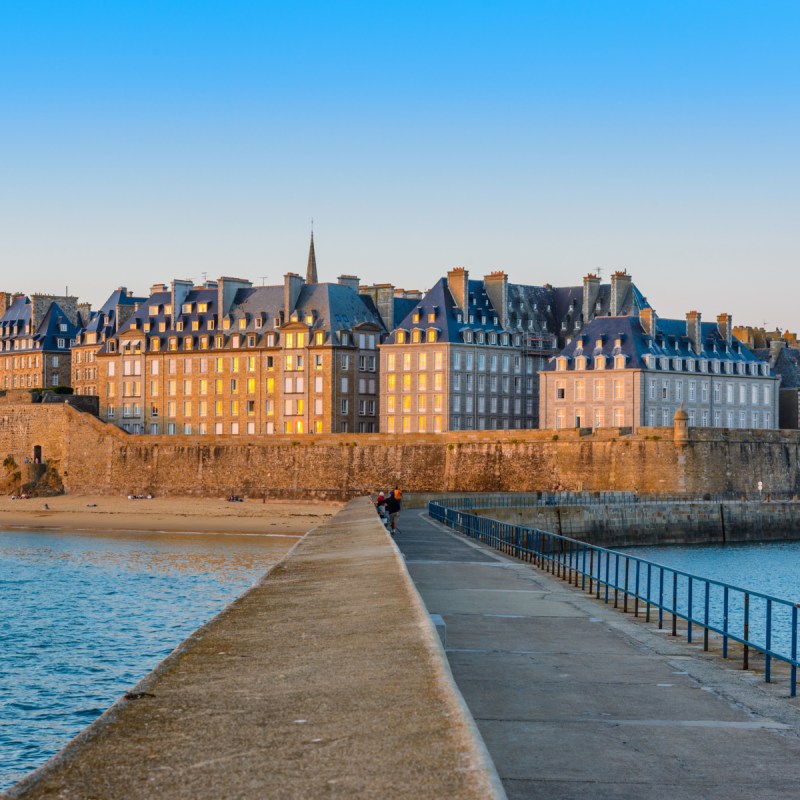
There are places in the world where you can turn a corner and it immediately seems like you have been transported to another age, and your surroundings look unchanged from centuries ago, as if time has stood still. Especially in Europe, with its many medieval town centers, time travel seems eminently feasible. Just replace the parked cars with carriages, the jeans people are wearing with breeches and long dresses, and you can easily imagine yourself in the place at another time.
Videos by TravelAwaits
The ease with which this is done is proven by the many series and films made in Europe. Just think of the Bridgerton series, filmed in Bath Spa , where time seems to have not changed anything in the city.
I have not included locations such as Pompeii or Greek historic sites, not because they do not allow time travel (in the case of Pompeii, time literally has stopped since the volcanic eruption), but instead listed destinations where modern life takes place within old surroundings and the historic quarters are used and integrated into day-to-day life.
Here are some of my favorite places in Europe where, in the blink of an eye, you can get transported to another era, turning your vacation into time travel.

1. Saint-Malo, France
One of my favorite places in France, Saint-Malo showcases its time warp potential perfectly. Step through the chunky city gates into the walled Intra Muros part of the city, and you leave the modern city outside behind you and find yourself in a medieval fortified village, complete with cobbled lanes, crooked houses, and those enormous ramparts from where the views across the tidal islands on Saint-Malo’s doorstep have not changed in centuries. Even the fishing boats seem to fit the scene. Just imagine a few corsair-captained ships on the horizon, and you are back in the 12th century.
Pro Tip: At night, sit out on Place Chateaubriand, where you can appreciate the old, fortified wall while enjoying a modern drink in hand.

2. Oxford, UK
Oxford always makes me gasp with how little this old university town has changed over the hundreds of years. The colleges, part of the overall University of Oxford, have been a center of learning since the 1200s and have barely changed except that now students carry laptops and use Wi-Fi in the ancient libraries. There are many pictures which highlight just how much of a time warp you can expect there, but the best way is to not only visit the colleges and libraries, but simply turn into the narrow alleys behind the main streets, where cars cannot reach, and you’ll see it for yourself.
Pro Tip: Don’t miss a visit to the Bodleian Library, where ancient and modern work hand in hand.

3. Venice, Italy
Imagine Venice without the tourists: the canals filled with gondolas, some bringing fresh produce to market, others taking a palazzo’s dirty laundry away. Scenes that have not changed at all over the years, and even more obvious in Venice due to the lack of cars. The buildings, the canals, the grand palazzi, even the small villages on the various islands in the lagoon are all as they have always been. Yes, there are modern water taxis and vaporetti, but now that the gigantic cruise ships are banned, it is only the people that look slightly out of place. But come at Carnevale, with everybody dressed up, and you will encounter a Venice where time stands still.
Pro Tip: For a true spectacle, book yourself into a proper costume ball, always hosted around Carnevale time.

4. Tbilisi, Georgia
Tbilisi, the capital of Georgia, is a heady mix of old and new, of different neighborhoods dating to different times. But Tbilisi’s old town, clinging to the hill between the imposing Narikala Fortress and the Kura River, looks like it did back in the 1300s, when merchants traveling the Silk Road stopped off to soothe their travel-weary bodies in the hot sulfur springs of Tbilisi. The many old bath domes, looking a little like upturned egg cartons, and the ravine where you can still see the springs emerging from the rockface, allow you to take a picture that would not have looked any different several hundred years ago.
Pro Tip: Walk up to Juma Mosque and turn into all the tiny, tiny lanes behind the private houses for great little discoveries.

5. Prague, Czech Republic
Standing in the main square, next to Prague’s town hall, facing the Tyn Cathedral and the beautiful astronomical clock operating since 1410 next to you, tilt your gaze up a little to cut out the modern-dressed passers-by, and you are back in a rich city in the Middle Ages. Turn toward the old Jewish Quarter with its atmospheric 15th-century cemetery, walk across Charles bridge, and you can see why this old city is so popular with those seeking out history that is still palatable today.
Pro Tip: One of the oldest streets in Prague is Havelská Street, which holds a daily market dating to 1232.

6. Avignon, France
It is quite rare for a well-traveled European like me to gasp at historic sights, but Avignon’s famous bridge and the gigantic Pope’s Palace had my jaw drop down, and I am still in awe. The entire old town of Avignon is still encased in a sturdy fortified city wall, with chunky gates, and inside nothing much has changed since the 11th century. In 1309 the Papal Palace became the official residence of the popes, and they lived well: The building dwarfs everything around it.
Next to the palace lies the Pont Saint-Bénézet, better known as the Pont d’Avignon. This lovely old bridge was originally built across the Rhone River in the late 1100s and has been in ruins since the mid-1600s. Standing on it, looking across to the Papal Palace and Avignon’s fortification next to it, is a step back into history.
Pro Tip: Another little time-stood-still moment can be had in Rue des Teinturiers, the street of the textile dyers, alongside the small stream.
7. Korcula, Croatia
There is nothing better than stepping through a gate, call it a portal to another time, and finding yourself in a place where time stood still. And if the gate is on an island in the Adriatic Sea, a walled city crammed full of buildings where people have lived the same way for hundreds of years, that’s simply perfect. The Old Town of Korcula is reputedly the birthplace of Marco Polo, giving it some serious travel street cred. The little island has been populated since 400 B.C. and has, over the millennia been occupied by everybody from the Goths to the Romans, Slavs, and Byzantines, giving it a fascinating history and cultural background.
Pro Tip: Do step outside of the city walls and explore the forested side of the island, too.

8. Rothenburg Ob Der Tauber, Germany
Never mind time travel, visiting Rothenburg ob der Tauber is like stepping into the pages of a fairy-tale book. This small town in northern Bavaria is brimming with crooked lanes and even crookeder half-timbered old buildings, dating back to the 12th and 14th centuries, seemingly unchanged by time or progress. To be fair, most of the buildings were destroyed during WWII, but have since been painstakingly reconstructed, even with the tilts and slants so typical for medieval buildings, and today barely a visitor is any the wiser. So, let’s ignore that fact and just enjoy the fairy tale, because, seriously, if a princess with a pointy hat and floating skirt and a dragon appeared in one of these lanes, you’d not even blink. One of the reasons they filmed a Harry Potter movie here.
Pro Tip: If you have the chance, visit in winter, preferably coinciding with the Christmas market and decorations in December.
9. Wells, UK
The smallest city in England, after the City of London, Wells is so well preserved that it is like stepping into a film set. There is the fabulous 13th-century cathedral, which incidentally allows in well-behaved dogs, and the moated Bishop’s Palace on which moat the famous Wells’ swans float and reportedly otters frolic, although I did not spot any despite patiently searching. The High Street full of cute pubs and cafes is crooked and quaint, and there is also Vicar’s Close, reportedly not only England’s but also Europe’s oldest residential street, accessed by yet another gate near the cathedral, and standing perfectly preserved for more than 650 years now.
Pro Tip: Wells has no train station, but you can catch bus 376 from Bristol Temple Meads.

10. Castellfollit De La Roca, Catalonia, Spain
This small town in the province of Girona in Catalonia, northern Spain, could not have changed over the years if it wanted to. Perched on top of a steep basalt cliff between the rivers Fluvià and Toronell, some 165 feet high and just over half a mile long, this is a somewhat precarious location for a town. The ancient houses of Castellfollit de la Roca, many made from lava-rock, are literally facing the abyss, with no space for expansion or indeed much change. Even stepping out of the backdoor could be seriously dangerous for some. Part of the volcanic region by the Pyrenees, the location of this town is scenic to say the least, and the narrow streets of the community together with the 11th-century church perched at the edge of the cliff are well worth a visit. But the best views of the incredible site are had from down below by the river.
Pro Tip: You can explore this and other medieval towns on a day trip from Barcelona.

